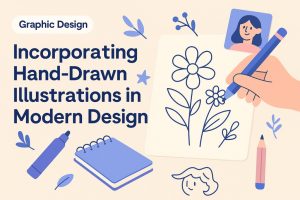To begin with, typography isn’t just about choosing a font—instead, it’s a visual language that shapes how people see your brand, interact with your content, and ultimately make decisions. For instance, in today’s fast-evolving digital space, staying updated on typography trends 2025 is absolutely essential for businesses, designers, and marketers alike. Moreover, fonts can speak volumes about your professionalism, creativity, and personality—so it’s crucially important to know what’s trending and what’s fading out in typography trends 2025.
Here are the top typography trends that are making waves in 2025 and those that are on their way out.
Why Typography Matters in Graphic Design
Firstly, Typography is the cornerstone of effective visual communication. In fact, it impacts readability, accessibility, and how emotionally connected your audience feels with your brand. For example, a well-chosen typeface can elevate a design, while a poorly chosen one can confuse or even repel your audience. Consequently, from website headers to social media ads, your font choices carry brand weight in the context of typography trends 2025.
What’s In: Typography Trends 2025
1. Variable Fonts
- Why it’s hot: Variable fonts allow multiple styles and weights in one file, thus making them flexible and performance-friendly.
- Use case: Particularly, they’re great for responsive design and digital interfaces, where scalability and speed matter.
2. Maximalist Typography
- Why it’s hot: Big, bold fonts with exaggerated serifs or experimental shapes are taking center stage.
- Use case: Perfect for hero sections, posters, and brand storytelling where making a statement is key.
3. Handwritten and Humanistic Fonts
- Why it’s hot: In an age of AI and automation, brands are seeking more warmth and personality.
- Use case: Great for personal brands, creative agencies, and wellness brands looking to build trust.
4. Kinetic Typography
- Why it’s hot: Motion in typography adds depth and dynamic interest, especially on social media and websites.
- Use case: Majorly, uses for reels, web animations, or explainer videos where visual engagement is crucial.
5. Retro-Futuristic Fonts
- Why it’s hot: Blending nostalgia with innovation, these fonts bridge vintage aesthetics with modern tech.
- Use case: Particularly, brands in tech, entertainment, or fashion use these to tap into millennial and Gen Z nostalgia.
What’s Out: Typography Trends Losing Steam
1. Overused Minimalist Sans-Serifs
- Why it’s fading: While clean and professional, some sans-serif fonts like Helvetica or Arial have become overused and generic.
- Alternative: Instead, try a custom geometric or semi-serif font to stand out while staying modern.
2. Ultra-Light Fonts
- Why it’s fading: Thin fonts often lack readability, especially on mobile and low-contrast backgrounds.
- Alternative: Instead, opt for medium weights that improve accessibility and screen legibility.
3. Overly Decorative Script Fonts
- Why it’s fading: Hard-to-read script fonts can feel outdated and impractical.
- Alternative: Rather, use clean cursive styles or hand-lettered fonts that balance flair and function.
4. Default System Fonts
- Why it’s fading: Fonts like Times New Roman or Calibri don’t express brand personality.
- Alternative: Instead, invest in custom or curated typefaces that align with your brand tone.
5. Inconsistent Font Pairing
- Why it’s fading: Mismatched fonts disrupt visual harmony and brand consistency.
- Alternative: Rather, choose font families with multiple weights/styles or use curated font pairings.
How to Choose the Right Typography for Your Brand
When selecting fonts for your brand, always ask:
- Does it reflect my brand’s personality?
- Is it readable across devices?
- Does it differentiate me from my competitors?
- Will it scale well for all mediums (print, web, mobile)?
Moreover, typography should feel intentional and cohesive, not like an afterthought. A strong typographic system helps you maintain consistency, which builds trust and recognition.
Best Practices to Keep in Mind
- Firstly, limit yourself to 2–3 typefaces per project, so designs stay clean.
- Next, ensure strong contrast between text and background, thus improving readability.
- Then, use hierarchy (font size, weight, spacing) to guide the reader, thereby enhancing flow.
- Also, test your typography on multiple screen sizes, so it works everywhere.
- Lastly, use web-safe fonts for fast load times, thus optimizing performance.
Stay Ahead by Staying On-Brand
Ultimately, typography is more than a design choice; instead, it’s a strategic decision that impacts how your audience engages with your brand. Moreover, following current trends while staying true to your brand voice is the key to creating designs that feel fresh yet familiar.
At Fuel IT Online, we help businesses and creatives design with intention. For instance, from typography to branding systems, our graphic design team ensures every element works together to make your brand unforgettable. So, if you’re ready to modernize your look and improve engagement? Then, Let’s talk about design that performs.




